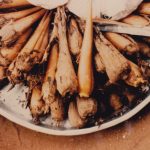Borassus ethiopium
Uses
Chad (central), Sudan (central and south, especially southern Darfur and southern Kordofan): fruit (drupe) eaten by sucking the juicy fibres. It is described as tasting acid and bitter. The hypocotyl, which appears about two months after the seeds are sown, is harvested, being very starchy, and is considered of great value in times of famine. Nigerian sample contained 31.73mg/100g of magnesium.
Additional Information
- Name Authority:
- Mart.
- Vernaculars:
- Arabic: Delep<, Daleib, Ron. English: African Fan Palm. Nigeria:giginya.
- Misc:
- Chemical composition: Protein (crude) = 2.8% (dry). Fat = 0.5% (dry). Ash (insoluble) = 3.5% (dry). Fibre (crude) = 16.8% (dry). Amino acids (g [16g N]-1): Aspartic acid = 9.3g. Threonine = 3.6g. Serine = 3.9g. Glutamic acid = 8.9g. Proline = 5.0g. Glycine = 5.0g. Alanine = 5.0g. Valine = 5.0g. Cysteine = 0.1g. Methionine = 1.2g. Isoleucine = 3.6g. Leucine = 6.1g. Tyrosine = 2.8g. Phenylalanine = 3.6g. Lysine = 3.9g. Histidine = 2.1g. Arginine = 2.4g. Minerals: Sulphur = 0.04% (dry). Potassium = 0.09% (dry). Magnesium = 0.10% (dry). Calcium = 0.08% (dry). Na = 0.01% (dry). Zinc = 4mg/kg (dry). Iron = 488mg/kg (dry). Manganese = 8mg/kg (dry). Copper = 2mg/kg (dry).
